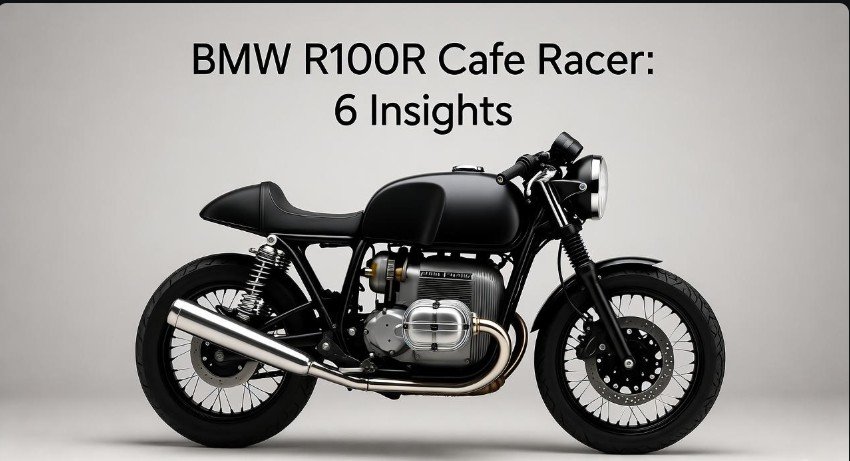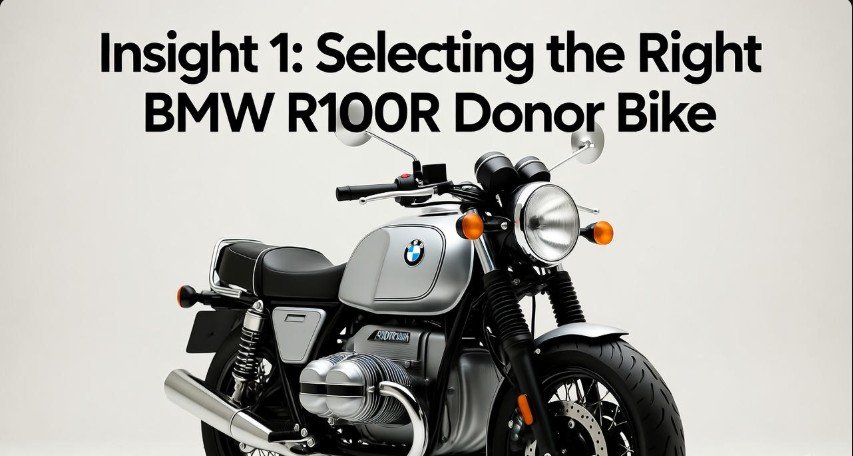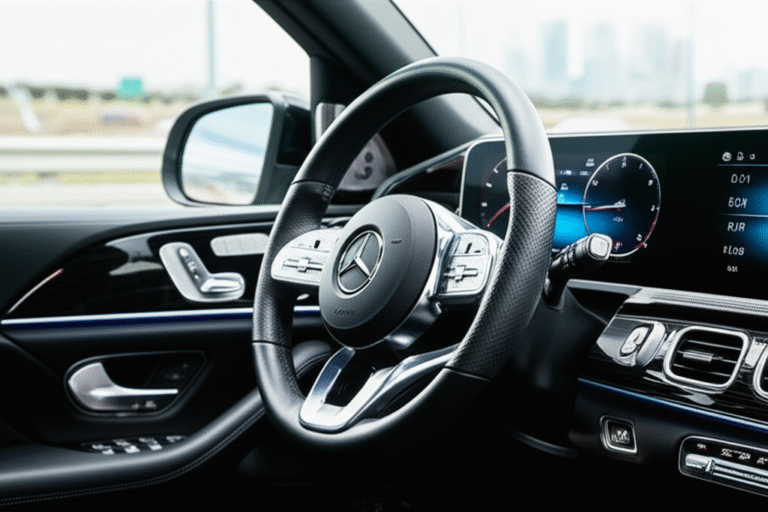BMW R100R Cafe Racer: 6 Insights

Transforming a BMW R100R into a cafe racer is a rewarding project, offering classic style and thrilling performance. Our 6 insights cover essential steps for a successful build, from sourcing the right bike to the final touches that define your custom BMW R100R Cafe Racer.
Key Takeaways
- Source a clean BMW R100R base for your cafe racer project.
- Prioritize essential cafe racer modifications for style and function.
- Understand the electrical system for seamless integration.
- Focus on handling and braking upgrades for safety.
- Embrace custom fabrication for a unique BMW R100R Cafe Racer.
- Budget wisely for parts, tools, and potential professional help.
Dreaming of a motorcycle that blends timeless elegance with spirited performance? The BMW R100R, with its robust boxer engine and classic lines, is a prime candidate for a cafe racer conversion. This iconic German machine offers a fantastic platform for personalization, allowing you to craft a truly unique ride. You might be wondering where to start or what key aspects to focus on when bringing a BMW R100R Cafe Racer to life. It doesn’t have to be an overwhelming process. We’ve gathered six essential insights to guide you through the journey, ensuring your build is both successful and enjoyable.
This guide will break down the most crucial elements, from selecting your donor bike to understanding the specialized modifications that define the cafe racer aesthetic. Let’s dive into the world of the BMW R100R Cafe Racer.
Insight 1: Selecting the Right BMW R100R Donor Bike

The foundation of any successful BMW R100R Cafe Racer build is the donor bike itself. Not all R100Rs are created equal when it comes to suitability for a cafe conversion. Your goal is to find a machine that requires the least amount of major mechanical work, allowing you to focus on the aesthetic and performance enhancements that define a cafe racer. This means a bike that runs well, has a relatively straight frame, and ideally, comes with some service history.
When inspecting potential bikes, pay close attention to the engine. Listen for any unusual noises, check for oil leaks, and ensure it starts without excessive cranking. The transmission should shift smoothly through all gears. The frame is paramount; inspect it meticulously for any signs of damage, cracks, or previous repairs. A bent frame will compromise handling and safety, and straightening one can be a costly and complex undertaking. While cosmetic flaws can be addressed, structural integrity is non-negotiable.
Consider the condition of the electrical system. Older bikes can have brittle wiring, corroded connectors, and failing components. While you’ll likely be upgrading or tidying up the wiring harness for a cafe build, a fundamentally sound original system will save you headaches. Look for bikes with as many original parts as possible, as this often indicates a well-maintained machine. Parts availability for the BMW R100 series is generally good, but original, hard-to-find components in good condition are a bonus.
The “R” designation in the R100R signifies the Roadster model, which often came with slightly different styling and components compared to other R100 variants. For a cafe racer, the R100R often provides a great starting point due to its more upright riding position (which will be altered) and robust frame. However, other R100 models, like the R100GS or R100RS, can also be converted, though they may require more extensive modifications to achieve the desired cafe look.
What to Look For in a BMW R100R Donor:
- Engine Health: Runs smoothly, no excessive smoke, minimal oil leaks.
- Frame Integrity: No cracks, bends, or significant rust.
- Transmission: Shifts cleanly through all gears.
- Electrical System: Lights, signals, and ignition function correctly.
- Documentation: Service history and clear title are highly desirable.
Finding the right starting point is crucial for a smooth and successful BMW R100R Cafe Racer build. It sets the stage for all the exciting modifications to come.
Insight 2: Essential Cafe Racer Modifications for the R100R
The cafe racer aesthetic is defined by a few key modifications that emphasize minimalism, performance, and a sporty riding posture. For your BMW R100R, these changes will dramatically alter its character. The most iconic element is the seat and tail section. Cafe racers typically feature a solo seat, often with a humped tail cowl that flows seamlessly from the subframe. This requires modifying or replacing the original subframe to create a clean, flat profile for the seat to mount on.
The handlebars are another critical component. To achieve the characteristic sporty stance, clip-on handlebars are standard. These mount directly to the fork tubes, below the top triple clamp, forcing the rider into a more aggressive, forward-leaning position. The original R100R handlebars will be replaced with these lower-mounted clip-ons. This change also influences the placement of instruments and controls.
Wheels and tires play a significant role. While the R100R typically came with alloy wheels, many builders opt for spoked wheels for a more vintage look. The size and profile of the tires will also be selected to complement the cafe racer style, usually leaning towards a sportier, more road-focused tread. Lowering the bike slightly, either through suspension modifications or by adjusting fork height, can further enhance the aggressive stance.
Lighting is also a key area for customization. A smaller, more focused headlight is a hallmark of cafe racers. The original large, often chrome-bezelled headlight of the R100R will likely be replaced with a sleeker, smaller unit. Similarly, minimalist taillights and turn signals contribute to the clean, uncluttered look. Many builders opt for integrated LED units for a modern touch on a classic design.
Exhaust systems are often modified or replaced. While the R100R’s boxer engine has a distinct sound, a custom exhaust – often a 2-into-1 or a pair of shorter, upswept mufflers – can enhance performance and contribute to the overall aesthetic. The goal is a system that sounds as good as it looks and performs.
Core Cafe Racer Elements for the R100R:
- Seat & Tail: Solo seat with a humped tail cowl.
- Handlebars: Clip-on bars for a sporty riding position.
- Front End: Smaller headlight, possibly lowered forks.
- Lighting: Minimalist taillight and turn signals.
- Exhaust: Custom pipes for performance and style.
- Wheels/Tires: Often spoked wheels with sportier tires.
These modifications are the building blocks of your BMW R100R Cafe Racer, transforming its utilitarian form into a sleek, performance-oriented machine.
Insight 3: Navigating the BMW R100R Electrical System
The electrical system of a motorcycle, especially an older one like the BMW R100R, can seem daunting. For a cafe racer build, this is often an area where significant simplification and upgrades occur. The goal for a cafe racer is typically to strip away unnecessary wiring, reduce weight, and ensure reliable power for essential functions and any new accessories.
The R100R utilizes a relatively straightforward electrical system for its era, typically featuring points ignition (though later models or conversions might use electronic ignition) and an alternator for charging. However, years of use can lead to corrosion in connectors, fraying wires, and failing components. Before you start stripping things down, it’s highly recommended to obtain a good, clear wiring diagram for your specific R100R model. Resources like the BMW Owners Association (BMW MOA) often have extensive archives and forums where such diagrams and expert advice can be found.
Many cafe racer builders opt for a full rewire. This involves removing the old harness, cleaning up the mounting points, and installing a new, custom-made harness. This is an excellent opportunity to simplify. You might remove the original instrument cluster in favor of smaller, minimalist gauges, or consolidate components. The headlight, taillight, and turn signals will be replaced, requiring new connections. A common upgrade is to a solid-state rectifier/regulator for improved charging efficiency and reliability over older mechanical units.
Consider the battery. A smaller, lighter battery, like a lithium-ion unit, can be a great weight-saving and space-saving modification, ideal for a stripped-down cafe racer. However, ensure the chosen battery is compatible with the charging system and has sufficient cranking amps for the R100R’s boxer engine. You’ll also need to decide on ignition. While the stock points system can be reliable, many builders upgrade to a solid-state electronic ignition module, which offers better spark consistency and reduces maintenance.
When working on the electrical system, safety is paramount. Always disconnect the battery before working on any wiring. Use proper tools for stripping and crimping wires, and ensure all connections are secure and insulated to prevent shorts. Take your time, label wires clearly, and test each circuit as you go. A faulty electrical system can be a major source of frustration and a safety hazard.
Electrical System Checklist for Your BMW R100R Cafe Racer:
- Wiring Diagram: Obtain a detailed diagram for your model.
- Battery: Consider a lighter, more compact battery.
- Ignition: Evaluate points vs. electronic ignition upgrades.
- Charging System: Check stator, alternator, and rectifier/regulator.
- Lighting: Plan for new headlight, taillight, and signals.
- Connections: Ensure all wires are properly terminated and insulated.
A well-executed electrical system upgrade is fundamental to a reliable and sleek BMW R100R Cafe Racer. It’s the nervous system of your custom build.
Insight 4: Enhancing Handling and Braking for Safety
While the cafe racer aesthetic is about style, a true performance machine also needs to handle and stop with confidence. The BMW R100R, while a capable motorcycle, benefits immensely from upgrades to its suspension and braking systems to match its sporting intentions and the capabilities of modern riding. This is where you ensure your BMW R100R Cafe Racer is as safe and fun to ride as it is beautiful.
Suspension: The original R100R suspension, while functional, can be improved. For the front forks, consider upgrading the springs and damping oil. Many aftermarket kits are available that can firm up the ride, reduce brake dive, and provide better control. Some enthusiasts also opt for cartridge emulators or even full replacement fork assemblies from more modern BMW models or aftermarket suppliers if seeking a significant performance leap. For the rear, the original twin shock absorbers can be replaced with higher-quality aftermarket units. Brands like Hagon, Öhlins, or Wilbers offer shocks that can provide adjustable preload, damping, and rebound, allowing you to fine-tune the ride to your preference and the bike’s new setup. Lowering links can also be installed if a lower ride height is desired, but care must be taken not to compromise suspension travel or ground clearance too much.
Braking System: The R100R typically came with disc brakes, which is a good starting point. However, rubber brake lines can degrade over time, leading to a spongy lever feel and reduced braking power. Replacing the stock rubber brake lines with braided stainless steel lines is a highly recommended upgrade. These lines are more rigid, provide better feel and feedback at the lever, and offer superior durability. Performing a complete brake fluid flush with high-quality DOT 4 fluid is also essential. For those seeking maximum stopping power, upgrading the brake calipers to more modern, multi-piston units and even a larger front brake disc can be considered, though this often requires custom fabricated mounting brackets and careful integration with the existing master cylinder.
Wheels and Tires: As mentioned earlier, wheel choice impacts handling. Lighter wheels reduce unsprung weight, improving suspension performance. When selecting tires, opt for modern sport-touring or performance tires. These offer significantly better grip, feedback, and wet weather performance than older tire designs. Ensure the tire sizes are appropriate for the rims and that they complement the overall geometry of the bike. Consult resources like RevZilla’s tire buying guides for insights into modern tire technology and selection.
Handling and Braking Upgrade Table:
| Component | Stock Condition | Cafe Racer Upgrade | Benefit |
|---|---|---|---|
| Front Forks | Standard damping, springs | Upgraded springs, oil, cartridge emulators, or replacement forks | Improved ride quality, reduced dive, better control |
| Rear Shocks | Basic twin shocks | Adjustable aftermarket shocks (preload, damping) | Tuned ride, better handling under load |
| Brake Lines | Rubber hoses | Braided stainless steel lines | Firmer lever feel, improved responsiveness, durability |
| Brake Fluid | Older fluid | Fresh DOT 4 fluid | Optimal braking performance, prevents corrosion |
| Tires | Older tread patterns | Modern sport-touring or performance tires | Superior grip, handling, and safety |
Investing in the handling and braking systems is crucial for making your BMW R100R Cafe Racer a joy to ride, rather than just a showpiece. It ensures you can safely exploit the performance of this classic machine.
Insight 5: The Art of Custom Fabrication for Your BMW R100R
While many bolt-on parts are available for cafe racer builds, the true magic of a custom BMW R100R Cafe Racer often lies in custom fabrication. This is where you personalize the bike to your exact vision and make it truly one-of-a-kind. Fabrication allows you to achieve seamless integration of components and create unique styling elements that set your build apart.
One of the most common areas for fabrication is the subframe. The R100R’s original subframe is typically designed to support a longer, dual seat. For a cafe racer, you’ll want a much shorter, often upswept or flatter subframe to accommodate a solo seat and tail cowl. This involves cutting off the original subframe and welding on a new one, fabricated from steel tubing. This requires welding skills and a good understanding of frame geometry to ensure the bike remains balanced and safe. Many builders create custom seat pans that bolt to this new subframe, allowing for easy removal or modification.
Beyond the subframe, custom fabrication can extend to numerous other areas. Mounts for the new headlight, instruments, battery box, or even custom side covers can be fabricated from sheet metal or tubing. If you’re opting for a unique exhaust system that doesn’t have readily available aftermarket headers or mufflers, custom exhaust work might be necessary. This could involve bending pipes, fabricating collector boxes, or creating custom mounting brackets.
The fuel tank is another potential area for custom work. While many R100R owners retain the stock tank due to its classic BMW shape, some might opt for a different tank profile, requiring custom fabrication for its mounting points. The goal is always a clean, integrated look where components appear to flow into each other rather than looking like they’ve been bolted on as an afterthought.
Learning basic fabrication skills like metal cutting, grinding, bending, and welding can be incredibly rewarding and cost-effective for a custom build. However, if these skills are beyond your current capabilities, it’s wise to seek out a reputable custom fabrication shop. They can bring your designs to life, ensuring structural integrity and a professional finish. Consider fabricators who specialize in motorcycle builds – they’ll understand the nuances of weight distribution, clearances, and aesthetic flow.
Fabrication Focus Areas for a BMW R100R Cafe Racer:
- Subframe: Custom fabrication for solo seat mounting.
- Seat Pan: Shaped to fit the custom subframe.
- Component Mounts: Brackets for headlight, instruments, battery.
- Exhaust System: Custom pipes or collector boxes.
- Bodywork: Custom fairings, oil coolers, or side covers.
- Fuel Tank: Adapting or modifying for new aesthetics.
| Fabrication Task | Required Skills | Tools | Considerations |
|---|---|---|---|
| Subframe Construction | Welding (TIG/MIG), tube bending, measuring | Welder, grinder, tube bender, metal cutting tools | Frame integrity, geometry, load capacity |
| Bracket Fabrication | Metal cutting, drilling, bending, basic welding | Hacksaw, drill press, bench grinder, welder | Secure mounting, vibration resistance |
| Sheet Metal Work | Cutting, shaping, riveting, basic welding | Sheet metal shears, hammers, anvil, riveting tools | Smooth curves, clean edges, weight reduction |
Embracing custom fabrication is key to creating a BMW R100R Cafe Racer that truly reflects your personal style and engineering vision.
Insight 6: Budgeting and Timeline Considerations
Embarking on a BMW R100R Cafe Racer project requires careful planning, especially concerning budget and timeline. It’s easy for costs to escalate quickly, and projects can often take longer than initially anticipated. Being realistic upfront will save you potential headaches and ensure you can complete the build without running out of funds or motivation.
Budget Breakdown: Start by estimating the costs of the core components. This includes the donor bike, which can vary significantly based on condition and mileage. Then, factor in the cost of major cafe racer parts: clip-on handlebars, new seat and tail cowl, smaller headlight, upgraded taillight/signals, exhaust system, and any suspension or brake upgrades. Don’t forget consumables like paint, primer, sealants, lubricants, and fasteners. Factor in tools you might need to purchase or rent. If you plan to outsource any fabrication or specialized work (like engine rebuilding or custom paint), get quotes early.
Contingency Fund: It’s almost guaranteed that unexpected costs will arise. A hidden crack in the frame, a seized bolt that needs to be drilled out, or a component that simply doesn’t fit can add to the bill. It’s wise to allocate a contingency fund of at least 15-20% of your estimated budget for these unforeseen issues.
Timeline Estimation: Building a motorcycle takes time. The R100R, being a relatively complex machine, requires patience. Research the typical timeframes for each modification. A complete rewire can take days or weeks, depending on your experience. Fabrication work can be time-consuming, especially if you’re learning as you go. Painting and finishing can also add significant time due to drying and curing processes. Be honest about your available free time and your skill level. A realistic timeline might be anywhere from a few months to over a year, depending on the complexity and your dedication.
Prioritization: If budget is a constraint, prioritize. Focus on the essential cafe racer modifications first: the seat/tail, handlebars, and basic lighting. Handling and braking upgrades are critical for safety and can be phased in later. Engine tuning and cosmetic finishes can also be addressed as funds allow. Many enthusiasts recommend getting the bike mechanically sound and safe to ride before diving deep into purely aesthetic upgrades.
Pro Tip: Keep a detailed spreadsheet of all expenses. This helps you track spending and identify areas where you might be over budget. It’s also a great record for future reference or if you ever decide to sell.
External Resources for Budgeting: Websites like Partzilla or J&P Cycles can give you an idea of part costs. Online forums dedicated to BMW motorcycles and cafe racers are invaluable for getting realistic cost and time estimates from builders who have already tackled similar projects.
| Budget Category | Estimated Cost Range (USD) | Notes |
|---|---|---|
| Donor Bike (BMW R100R) | $3,000 – $8,000+ | Varies greatly by condition, mileage, and rarity. |
| Cafe Racer Parts Kit | $800 – $2,500+ | Includes seat, tail cowl, clip-ons, headlight, exhaust. |
| Electrical Components | $200 – $600 | Wiring harness, battery, ignition components, lights. |
| Suspension & Brakes | $300 – $1,000+ | Shocks, fork internals, brake lines, pads. |
| Custom Fabrication (if outsourced) | $500 – $2,000+ | Subframe, brackets, custom welding. |
| Paint & Finish | $200 – $1,000+ | Depends on DIY vs. professional. |
| Tools & Consumables | $100 – $500+ | Fluids, fasteners, cleaning supplies, specialized tools. |
| Contingency (15-20%) | Varies | Essential for unexpected costs. |
Realistic budgeting and timeline planning are essential for a rewarding BMW R100R Cafe Racer build. It allows for a smoother process and a much higher chance of project completion.
Frequently Asked Questions (FAQ) About BMW R100R Cafe Racers
What is a cafe racer?
A cafe racer is a style of motorcycle that originated in the 1960s, characterized by its minimalist, stripped-down appearance, lower clip-on handlebars, and a more aggressive, forward-leaning riding position, evoking a sporty, performance-oriented aesthetic.
Is a BMW R100R a good bike for a cafe racer conversion?
Yes, the BMW R100R is an excellent platform for a cafe racer conversion. Its robust boxer engine, classic styling, and strong frame provide a solid foundation for these modifications.
How much does it typically cost to build a BMW R100R Cafe Racer?
The cost can vary widely, from $5,000 to $15,000 or more, depending on the condition of the donor bike, the quality of parts used, and whether you perform the work yourself or hire professionals.
What are the most common modifications for an R100R cafe racer?
Common modifications include replacing the handlebars with clip-ons, installing a solo seat with a tail cowl, upgrading to smaller lights, fitting a custom exhaust, and often re-wiring the electrical system for simplicity.
Do I need special skills to convert a BMW R100R into a cafe racer?
Basic mechanical knowledge is helpful, but advanced skills in welding, fabrication, and electrical work are often required for a professional-looking and functional build. Many builders learn these skills during the project.
Can I keep my R100R street legal after converting it to a cafe racer?
Yes, but you must ensure all modifications comply with local state and federal regulations regarding lighting, noise emissions, mirrors, and other safety features. Always check with your local Department of Motor Vehicles (DMV) or equivalent authority.
Where can I find parts for a BMW R100R Cafe Racer build?
Specialty motorcycle parts suppliers, online forums (like BMW MOA), custom bike builders, and even DIY fabrication are common sources for parts. Restoring original components can also be an option.
The journey to creating your own BMW R100R Cafe Racer is a deeply personal and rewarding one. It’s a blend of mechanical skill, artistic vision, and a passion for classic motorcycles. By understanding these six core insights – from selecting the right base bike and mastering essential modifications to navigating the electrical system, enhancing performance, embracing custom fabrication, and planning your budget – you’re well-equipped to embark on this exciting project. The BMW R100R, with its enduring appeal, offers a fantastic canvas for a build that’s both a joy to ride and a testament to your dedication. Take your time, enjoy the process, and soon you’ll be cruising the streets on a truly unique machine.


